We may not have the course you’re looking for. If you enquire or give us a call on 01344203999 and speak to our training experts, we may still be able to help with your training requirements.
Training Outcomes Within Your Budget!
We ensure quality, budget-alignment, and timely delivery by our expert instructors.

Muscles play a pivotal role in our everyday movements and bodily functions. They work in magical way, letting our bodies move and work efficiently. Thus, understanding the Difference Between Skeletal and Smooth Muscles is crucial for grasping the complexity of our physiological systems. Read this blog to learn about the Difference Between Skeletal and Smooth Muscles and learn how their contractions work to make daily movements in our body.
Table of Contents
1) What are Skeletal Muscles?
2) Characteristics of Skeletal Muscles
3) What are Smooth Muscles?
4) Characteristics of Smooth Muscle
5) Difference between Skeletal Muscle and Smooth Muscle
6) Conclusion
What are Skeletal Muscles?
Skeletal Muscles are essential for body movements. Skeletal Muscle tissue connects closely to bones and comprises striped Muscle fibres, like those found in the biceps, arranged parallel within Muscle bundles. A protective layer of connective tissue envelops these fibres. Here's how the structure of a Skeletal Muscle looks like:

Characteristics of Skeletal Muscles
Listed below are some of the main characteristics of Skeletal Muscles. Let's have a quick look:
Voluntary control: Skeletal Muscles are under conscious control, allowing deliberate movement like walking or reaching.
Striated appearance: These Muscles show a striped or banded pattern under a microscope due to their organised structure.
Attachment to bones: They connect to bones via tendons, enabling the body's movement and stability.
Multinucleated cells: Skeletal Muscle cells have multiple nuclei, aiding in their strength and repair.
Fatigue resistance: While they can tire, skeletal Muscles exhibit endurance for sustained activities.
Rapid contraction: They contract relatively quickly, contributing to swift movements and responses.
Controlled by the nervous system: Skeletal Muscles respond to signals from the nervous system, allowing for precise and coordinated movements.
Adaptability and growth: These Muscles can increase in size (hypertrophy) or decrease (atrophy) based on usage, exercise, or inactivity. As a result, they show remarkable adaptability to varying conditions.
What are Smooth Muscles?
Smooth Muscle fibres have a spindle-like shape, lacking the striped appearance seen in other Muscle types. Unlike Striated Muscles, their cohesion relies on cell connections alongside protective coverings akin to other Muscles. Typically found in the linings of internal organs like the stomach, intestines, and blood vessels, these Muscles operate involuntarily, functioning without direct control. Here's how the structure of a Smooth Muscle looks like:

Characteristics of Smooth Muscle
Discussed below are some of the characteristics of Smooth Muscles:
Involuntary control: Smooth Muscles operate involuntarily, managing various internal organ functions without conscious direction.
Lack of striations: Unlike Skeletal Muscles, Smooth Muscles lack the striped appearance and typically have a spindle-shaped structure.
Cell connections: Cell junctions play a significant role in holding Smooth Muscle fibres together, ensuring their collective function.
Presence of connective tissue sheaths: Similar to other Muscle types, Smooth Muscles are enveloped by protective connective tissue coverings.
Location in internal organs: They line the walls of internal organs, including the stomach, intestines, and blood vessels, contributing to organ functionality.
Slow, sustained contractions: Smooth Muscles contract more slowly than Skeletal Muscles. As a result, they aid in prolonged functions like maintaining blood pressure or digestion.
Multi-unit and single-unit types: Smooth Muscles exist in two forms—multi-unit, found in structures like blood vessels, and single-unit, prevalent in organs, each exhibiting distinct functionalities and response to stimuli.
Response to hormonal and nervous signals: They are regulated by both hormonal and Nervous Systems. These Muscles adjust their contractions in response to various internal and external stimuli for organ and vessel function regulation.
|
Characteristic |
Skeletal Muscle |
Smooth Muscle |
|
Location |
Attached to bones by tendons |
Walls of internal organs (e.g., stomach, intestines, blood vessels) |
|
Control |
Voluntary (under conscious control) |
Involuntary (not under conscious control) |
|
Appearance |
Striated (striped) under a microscope |
Non-striated (smooth) under a microscope |
|
Nuclei |
Multinucleated fibres |
Single nucleus in each cell |
|
Contraction type |
Quick and powerful |
Slow and sustained |
|
Function |
Enables movement (e.g., walking, running) |
Facilitates involuntary processes (e.g., digestion, blood circulation) |
|
Structure |
Long, cylindrical fibres |
Short, spindle-shaped cells |
|
Antagonistic action |
Work in pairs for movement |
Contract rhythmically and continuously |
Discover a path to wellness with our Healthy Lifestyles Training – embrace a vibrant and balanced life today!
Difference between Skeletal Muscle and Smooth Muscle
Skeletal Muscles and smooth Muscles are two distinct types of Muscle tissues, each with unique characteristics and functions within the human body. Here are some of the major differences between Skeletal Muscle and Smooth Muscle:
Skeletal Muscles, also known as Striated or Voluntary Muscles, are coupled to the bones by tendons and are under conscious control. These Muscles enable movement, such as walking, running, and grasping objects. They are named "striated" due to their striped appearance under a microscope, caused by the arrangement of Muscle fibres.
On the other hand, Smooth Muscles, also called Involuntary or Non-striated Muscles, are found in the walls of internal organs, like the stomach, intestines, and blood vessels. Unlike Skeletal Muscles, Smooth Muscles operate involuntarily, meaning they are not under conscious control. Their contractions are slow and sustained, facilitating functions like digestion, blood circulation, and organ processes. Smooth Muscles lack the striations seen in skeletal Muscles, appearing smooth under microscopic examination.
Structurally, Skeletal Muscles consist of long, multinucleated fibres, while Smooth Muscles have shorter, spindle-shaped cells with a single nucleus. Skeletal Muscles work in pairs; one Muscle contracts while the other relaxes, providing the necessary antagonistic action for movement. In contrast, Smooth Muscles contract rhythmically and continuously, maintaining a steady pressure or flow within organs.
Skeletal Muscle Contractions
Skeletal Muscle contractions are under voluntary control, meaning they respond to conscious commands, allowing for intentional movements. These contractions are characterised by their quick and rapid cycles of contraction and relaxation. This enables swift and coordinated actions.
The activation of Skeletal Muscle contractions involves the binding of calcium with troponin, a process pivotal in initiating the Muscle's response. These contractions rely solely on neural input, with signals from the nervous system orchestrating the Muscle's movements. Skeletal Muscles are typically attached to bones and tendons, facilitating movement and stability in the body.
Discover the power to shape a healthy and vibrant life with our Active and Healthy Lifestyles Training – transform your well-being today!
Smooth Muscle contractions
Smooth Muscle contractions are involuntary, operating without conscious direction. They exhibit a slower and more sustained pattern of contraction and relaxation, suited for functions that require endurance. Initiated by the binding of calcium with calmodulin, this process triggers the cycling of cross-bridges, influencing the Muscle's activity.
Unlike Skeletal Muscles, Smooth Muscle contractions are influenced by neural, hormonal, or chemical changes, adapting their contractions to various internal and external stimuli. These Muscles are predominantly found lining the walls of internal organs like the stomach, intestines, and blood vessels. It plays a crucial role in organ functionality and regulation.
Conclusion
In this blog, we've looked deeply into the Difference Between Skeletal and Smooth Muscles. We talked about how Skeletal Muscles move quickly in our bodies, unlike Smooth Muscles, which work independently and stay contracted for longer. We hope that you have gained a better understanding of the structure of both the Muscles through this blog.
Start sculpting your path to a healthier you with Nutrition And Fitness Training – join now!
Frequently Asked Questions
Upcoming Health & Safety Resources Batches & Dates
Date
 Nutrition and Fitness Training
Nutrition and Fitness Training
Fri 26th Jul 2024
Fri 18th Oct 2024







 Top Rated Course
Top Rated Course



 If you wish to make any changes to your course, please
If you wish to make any changes to your course, please


